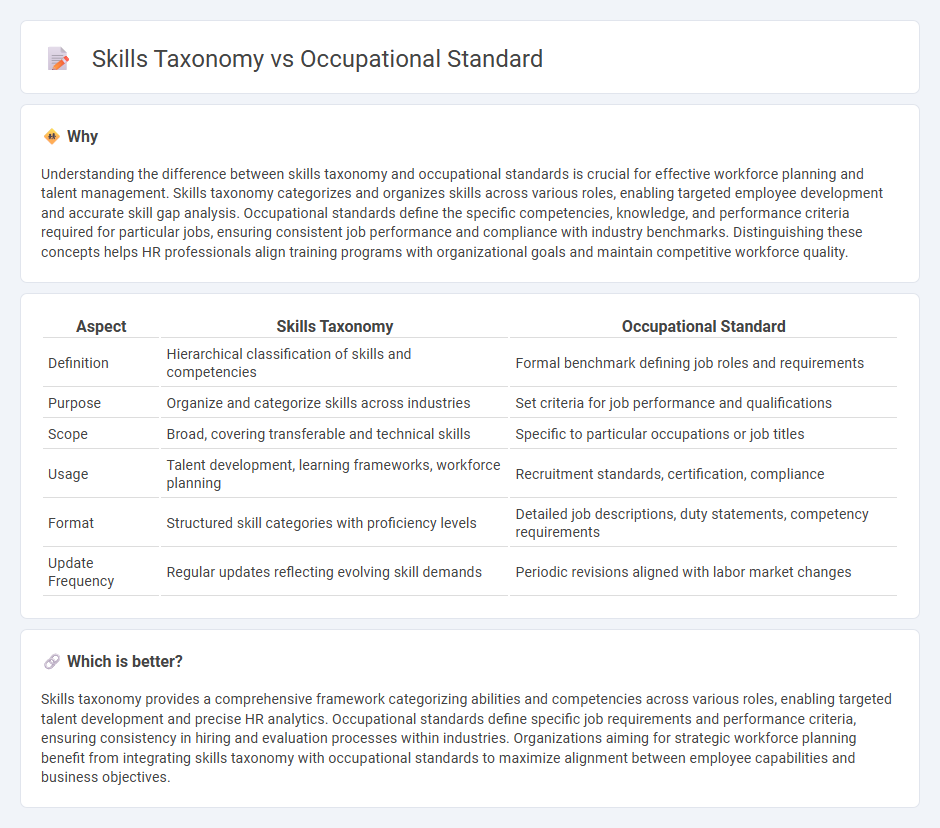
Skills taxonomy organizes and categorizes employee competencies to streamline talent management and training programs, while occupational standards define the specific requirements and qualifications needed for particular job roles. Both frameworks play crucial roles in aligning workforce capabilities with organizational goals and regulatory compliance. Explore how integrating skills taxonomy with occupational standards enhances HR strategies and workforce development.
Why it is important
Understanding the difference between skills taxonomy and occupational standards is crucial for effective workforce planning and talent management. Skills taxonomy categorizes and organizes skills across various roles, enabling targeted employee development and accurate skill gap analysis. Occupational standards define the specific competencies, knowledge, and performance criteria required for particular jobs, ensuring consistent job performance and compliance with industry benchmarks. Distinguishing these concepts helps HR professionals align training programs with organizational goals and maintain competitive workforce quality.
Comparison Table
| Aspect | Skills Taxonomy | Occupational Standard |
|---|---|---|
| Definition | Hierarchical classification of skills and competencies | Formal benchmark defining job roles and requirements |
| Purpose | Organize and categorize skills across industries | Set criteria for job performance and qualifications |
| Scope | Broad, covering transferable and technical skills | Specific to particular occupations or job titles |
| Usage | Talent development, learning frameworks, workforce planning | Recruitment standards, certification, compliance |
| Format | Structured skill categories with proficiency levels | Detailed job descriptions, duty statements, competency requirements |
| Update Frequency | Regular updates reflecting evolving skill demands | Periodic revisions aligned with labor market changes |
Which is better?
Skills taxonomy provides a comprehensive framework categorizing abilities and competencies across various roles, enabling targeted talent development and precise HR analytics. Occupational standards define specific job requirements and performance criteria, ensuring consistency in hiring and evaluation processes within industries. Organizations aiming for strategic workforce planning benefit from integrating skills taxonomy with occupational standards to maximize alignment between employee capabilities and business objectives.
Connection
Skills taxonomy categorizes and organizes competencies required across various jobs, enabling clearer identification of skill gaps and workforce planning. Occupational standards define the specific knowledge, skills, and abilities needed to perform particular roles effectively, serving as benchmarks for training and assessment. Together, they align workforce development efforts by linking skill classifications with industry-recognized job requirements, enhancing employee performance and career progression.
Key Terms
**Occupational Standard:**
Occupational standards define the specific competencies, performance criteria, and conditions required for effective job execution, serving as a benchmark for evaluating employee qualifications and training outcomes. They provide detailed descriptions of job roles, tasks, and necessary knowledge, ensuring alignment with industry expectations and legal regulations. Explore how occupational standards enhance workforce development and certification accuracy.
Job Competency
Occupational standards define the essential competencies and performance criteria required for specific job roles, while skills taxonomy categorizes and organizes these competencies into hierarchical frameworks for easier reference and development. Job competency focuses on the measurable abilities, knowledge, and behaviors necessary to perform job tasks effectively within occupational standards. Explore further to understand how integrating these frameworks can enhance workforce development and talent management.
Performance Criteria
Performance Criteria in occupational standards define specific, measurable outcomes required to demonstrate competency in a job role, ensuring clear benchmarks for assessment and certification. Skills taxonomies categorize and organize these competencies into a hierarchical structure, facilitating skill identification and development across industries. Explore the distinctions and applications of Performance Criteria within these frameworks to enhance workforce development strategies.
Source and External Links
What is an occupational standard? - An occupational standard is a concise description of an occupation detailing the knowledge, skills, and behaviours required to perform the job competently, used for apprenticeship development, training, and assessment purposes.
What is an Occupational Standard? - Red Seal - Red Seal Occupational Standards define everything a tradesperson needs to know including trade tasks, skills, safety, and performance expectations to support training and certification.
WorldSkills Occupational Standards - These standards represent global work roles, specifying the skills, knowledge, and abilities required for vocational performance worldwide and are updated regularly with industry input.
 dowidth.com
dowidth.com